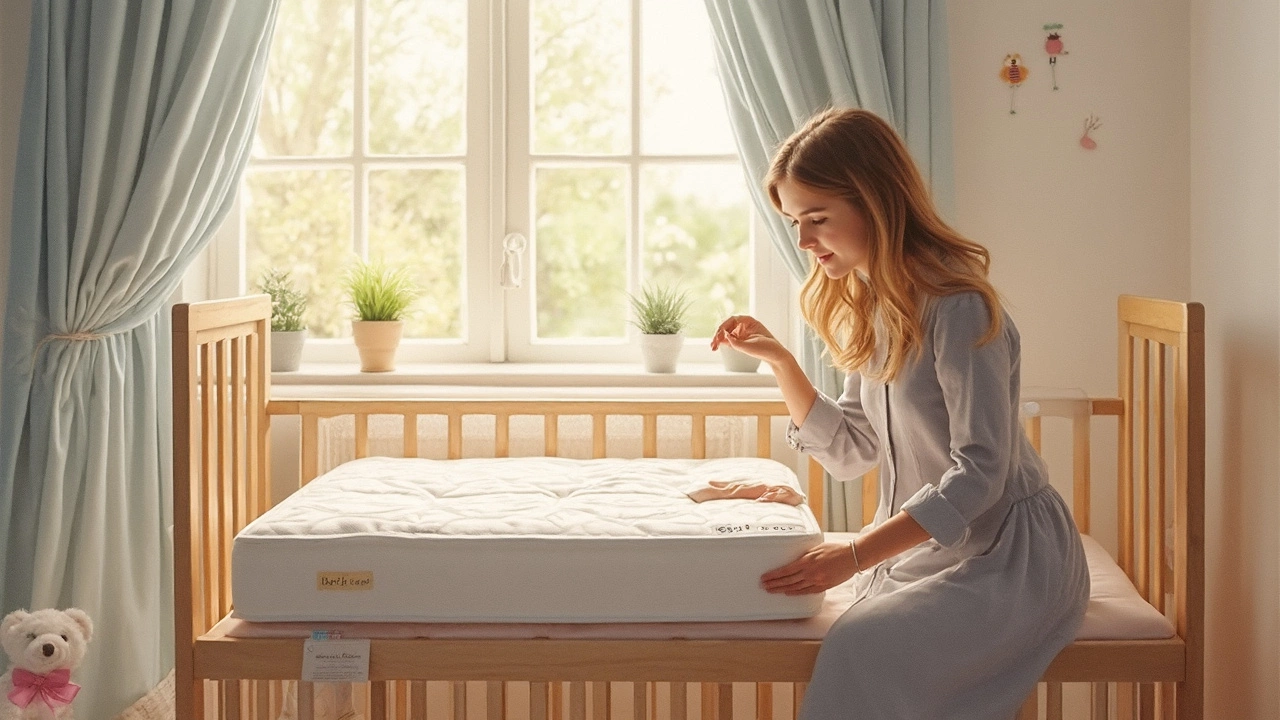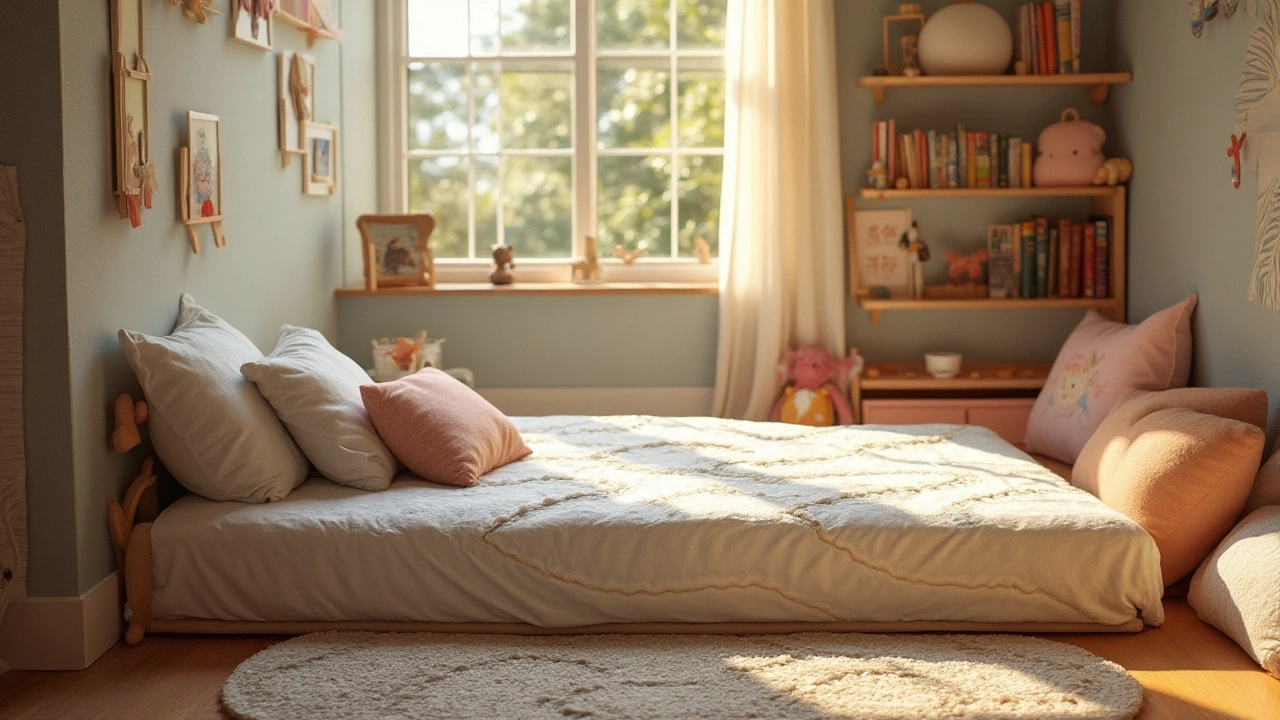Do Toddlers Need a Firm or Soft Mattress for Better Sleep?

The great mattress debate: should your toddler snooze on something firm or soft? It's a question many parents grapple with, and the answer isn't as clear-cut as it might seem. Understanding your toddler's needs is crucial in making the best choice.
A firm's mattress offers the benefit of support. For toddlers, whose spines are still developing, this can be essential. Too much give in a mattress could mean their body isn't getting the support it needs. Plus, there's a safety angle—firmer mattresses reduce the risk of suffocation.
But, a soft mattress isn't without merit. Some parents believe it offers a cozy, comfortable night's sleep, which is pretty important when you're trying to keep bedtime fuss to a minimum. However, the plushness can sometimes lead to overheating or feeling 'engulfed.'
In deciding between firm and soft, consider your toddler's unique preferences and any advice from pediatricians or sleep experts. A balance between comfort and safety is key. And while you're at it, think about other practical factors like mattress size, material, and durability—the last thing you want is a mattress that doesn't stand up to the occasional milk spill or roughhousing!
- Importance of Mattress Type
- Firm vs Soft: What's Better?
- Safety Concerns
- Health Implications
- Making the Right Choice
- Tips for Transitioning to a Big Kid Bed
Importance of Mattress Type
Choosing the right toddler mattress is about more than just comfort. It's essential for your child's health and development. The mattress type you choose can significantly impact your child's quality of sleep, physical development, and safety.
Supporting Development
At this stage, toddlers' bones are growing rapidly. A firm mattress ensures proper alignment and support, which is vital for healthy bone development. It helps keep their spine in a neutral position, promoting better posture and potentially preventing back issues later on.
Avoiding Health Risks
Safety is a big concern, too. Soft mattresses might pose suffocation risks, especially for young toddlers who are still quite mobile in bed. A firm mattress can reduce these risks, providing a safer sleeping environment. Always check the firmness by pressing into the mattress—the surface should spring back quickly.
Sleep Quality
Good sleep is crucial for a child's mood, learning, and behavior. With the right mattress, toddlers are more likely to sleep soundly, and we all know what a blessing that can be. A study on sleep quality in children found that those with the right sleep environment, which includes the type of mattress, tended to have fewer sleep disruptions like waking up at night or difficulty falling asleep.
If you're picking a new toddler mattress, remember that it's more than just a notch in your parenting belt—it’s an essential part of your toddler's well-being and development journey.
Firm vs Soft: What's Better?
Deciding between a firm or soft mattress for your toddler can feel like a daunting task. It's not just about comfort; it's about balancing a slew of factors like safety, support, and growth. So, let's break it down.
Pros and Cons of Firm Mattresses
Firm mattresses are often recommended by pediatricians as they provide the necessary support for a toddler's growing bones. Your toddler's spine is in a constant state of development, and a firm surface provides the optimal alignment needed for healthy growth. Also, they are recognized for their contribution to a safer sleep environment, minimizing the risk of suffocation or SIDS.
| Firm Mattress Pros | Firm Mattress Cons |
|---|---|
| Provides support for growing bones | Might feel uncomfortable initially |
| Better spinal alignment | Less cushy feel |
| Reduced suffocation risk | Can be firm for sensitive children |
Advantages of Soft Mattresses
On the flip side, a soft mattress might offer the cushiony comfort your toddler adores. Soft mattresses can be especially appealing if your child is a side sleeper or used to plush surfaces like a parent’s bed. This can make bedtime transitions smoother and less of a battle.
"When it comes to choosing the right mattress, consider your child's comfort and safety above all," advises Dr. Emily Jensen from the National Sleep Foundation.
- Comfort: Offers a plush feeling that makes bedtime enticing.
- Cozy Setup: Might make it easier for a child accustomed to softer surfaces.
Striking a Balance
While both options have their benefits, striking the right balance is often the way to go. Some mattresses offer a dual-firmness design, providing a firm side for infants and a slightly softer side for toddlers—best of both worlds!
No matter which mattress you choose for your toddler bed, ensure it fits snugly in the bed frame to avoid gaps. It's also a good idea to keep an eye on any wear and tear, as mattresses wear out sooner with jumping toddlers around!
Safety Concerns
When it comes to your toddler's sleep, safety is the biggie you can't overlook. Choosing the right mattress isn’t just about comfort—it's also about keeping your little one safe.
Firmness Matters
A firm mattress is often recommended for toddlers as it reduces the risk of suffocation. A surface that's too soft can become a hazard, especially if your child ends up face down. That little extra firmness can mean a serious improvement in sleep safety.
Size and Fit
Make sure the mattress fits snugly in the bed frame. Gaps between the mattress and the sides of the bed can pose an entrapment risk. A correctly-sized toddler mattress ensures that those gaps aren't an issue.
Materials and Hypoallergenic Options
The materials used in a mattress are equally significant. Mattresses made with hypoallergenic materials can prevent skin irritations and allergies. This not only contributes to safety but also a healthier sleep environment.
Durability and Cleanliness
A mattress that can't stand up to a toddler's jumping antics or a night-time accident isn't worth its while. You'll want one that's not only sturdy but also easy to clean. Stains and spills are a given, so materials that dry quickly or can be wiped down easily make a difference.
- Toddler mattress materials should be breathable to avoid overheating.
- Look for certifications like GREENGUARD to ensure it meets standards for low chemical emissions.
- Check that the mattress cover is washable, as this will be a lifesaver during those unexpected mishaps.
By tackling these safety concerns head-on, you’re not only giving your child a better night’s sleep, but you’re also giving yourself peace of mind.

Health Implications
When thinking about your toddler's sleep, health implications of your mattress choice can't be ignored. A toddler's mattress impacts more than just sleep; it influences posture and physical development.
The Role of Firmness in Spinal Health
Let's talk spine. A firm mattress offers crucial support, especially for a toddler's growing body. Their bones are in the formative stages, and proper alignment during sleep can help prevent future orthopedic issues. On a firm mattress, your child’s spine stays aligned, reducing the risk of discomfort and potential aches as they grow.
Comfort and Development
Now, comfort is king for a good night's sleep, but it should balance health needs. While a softer mattress might seem cozy, if it's too soft, it could lead to poor sleeping posture. This is why pediatricians often recommend firmer options for kids’ growing bodies.
Sleep Quality and Mental Growth
Quality sleep is tied to mental development. A mattress that supports uninterrupted sleep helps toddlers hit those critical sleep quality stages, essential for their brain development. A study at Baby Sleep Institute revealed that toddlers who had a consistent, supportive sleeping environment showed improved cognitive function.
Allergies and Material Safety
Besides firmness, mattress material matters too. Hypoallergenic mattresses can prevent allergies, especially in sensitive children. Always check for certifications indicating low chemical emissions, like those marked with CertiPUR-US, reducing potential health issues from VOCs (volatile organic compounds).
Making the Right Choice
Choosing the perfect mattress isn't exactly rocket science, but it's not a decision to take lightly either. Let’s delve into the specifics to find the right balance that helps your toddler sleep soundly through the night.
Consider Your Toddler’s Needs
First things first, you need to think about what your little one finds comfy. Every toddler is unique, so while one might like a rock-hard mattress, another might drift off better on something softer. Pay attention to their sleep patterns and preferences, if possible.
Think Safety First
Always prioritize safety. The American Academy of Pediatrics recommends a firm mattress to minimize the risk of suffocation and that awful phenomenon known as SIDS (Sudden Infant Death Syndrome). Firmness doesn’t mean discomfort, so don’t worry about your toddler sleeping on a slab of concrete—it just means less squish and more support.
"Choosing a firm mattress for your toddler isn’t just about comfort; it’s a crucial step in ensuring their safety during sleep," says Dr. Emily White, a pediatric sleep specialist.
Durability and Practicality
Your little one's mattress should stand the test of time and toddlerhood. If spills and accidents are a concern, look for waterproof options or consider using a mattress protector. Durability also means the mattress won’t sag or wear out too soon, keeping the contour-seeking activities in check.
Material Matters
Don’t forget to consider the mattress material. Innerspring mattresses are often recommended for their firm support, but memory foam can sometimes be a tad too soft for toddlers. If you go for foam, ensure it’s high-density. Check labels for material safety standards to avoid any toxic materials sneaking in.
Budget Without Compromise
Lastly, let’s talk about money. High price doesn't always equal quality. Do a bit of homework with reviews and recommendations. Investing in a quality mattress from the get-go can save you cash and fuss down the line. Just remember to prioritize comfort, safety, and durability over fancy brand names.
In the end, the key is to strike a balance that ensures your toddler’s comfort and safety. After all, a night of sound sleep quality is priceless!
Tips for Transitioning to a Big Kid Bed
Moving your toddler to a big kid bed is a huge milestone, filled with excitement and a smidge of parental worry. But fear not! With a little planning, this transition can be as smooth as that soft mattress you were considering.
Start with the Right Timing
When’s the best time to make the switch? Usually, it’s around 18 to 36 months, when your little one starts climbing out of the crib or suddenly seems too big for it. Trust your instincts and watch for cues that they're ready.
Involve Your Toddler
Let them have a say! Take them along when picking out their new bed and bedding, so they're excited and more willing to embrace the change. A bedsheet in their favorite color or a themed blanket can make a huge difference.
Make the Room Safe
Before the transition, ensure the room is child-proofed. Anchor furniture to walls, cover electrical outlets, and remove any choking hazards. Safety is key as they gain newfound freedom!
- Toddler Mattress: Choose a firm mattress for a good night's sleep and to support their growing body.
- Bed Rails: Consider using bed rails to prevent falls during the night until they adjust to the new bed.
Establish a Routine
A consistent bedtime routine helps them feel secure. Whether it’s a bedtime story, a lullaby, or a quick cuddle, make it something your child can rely on every night.
Be Patient
This transition can sometimes come with setbacks, like nighttime wanderings or early morning visits to your bed. Consistency and patience are your best friends during this period. Reassure them and walk them back to their bed if they stray.
Fun fact: According to a 2022 survey, about 60% of parents reported their child adjusted to a new bed within two weeks. So hang in there!
Celebrate the Milestone
Once they're settled, celebrate this milestone with a small reward or fun activity. Positive reinforcement can boost their confidence and make them proud of their achievement.
Transitioning to a big kid bed is a big step for both of you. With these tips, your toddler will be dreaming sweet dreams in their new setup in no time!
